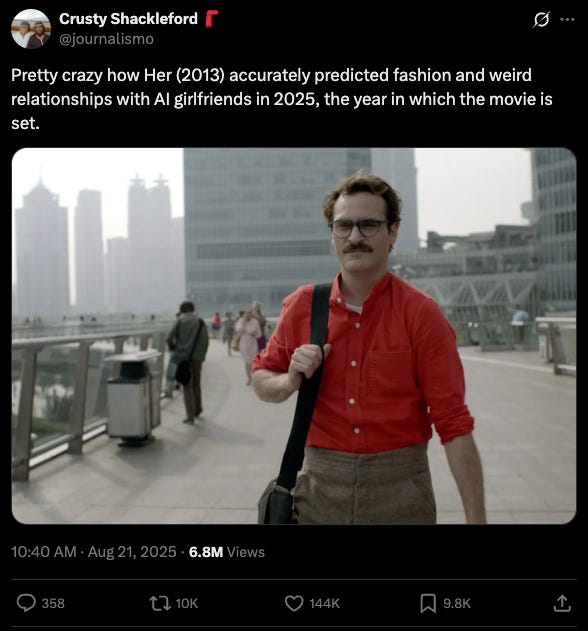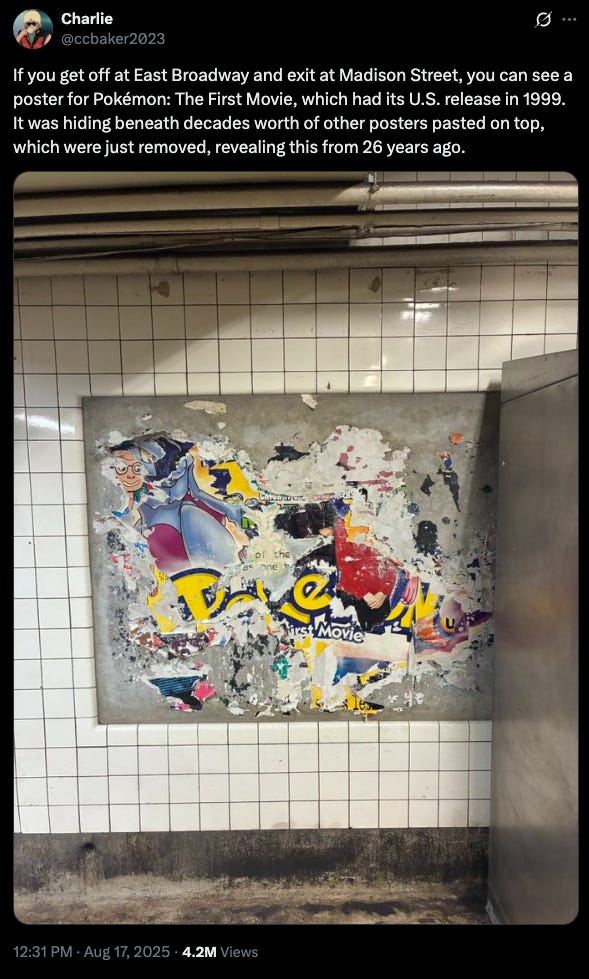Sunday Edition #12 - Rethinking Cinema (by Making It More Communal)
Also: Urban Archeology, Hiding Character Goals from the Reader, and new Tourist
Welcome to the Sunday Edition where I share interesting articles and links alongside what I’ve been up to!
Rethinking Cinema
I really enjoyed this essay from Thomas Flight on why movies will never feel the same again.
A particular interesting point comes at the end when he makes various proposals on “saving cinema”. One of the ideas is simply to have cinema lean in far more on being communal. The most “popular” recent cinematic experiences are when the audience become aware of each other: it’s cheering during Avengers, or shouting “Chicken Jockey” during Minecraft. In the film, Cinema Paradiso (one of my favourite films), depicting a cinema in small town Sicily, it shows just how “communal” the cinema used to be.
I remember growing up in a small town in South Africa with only one cinema, and going to watch movies there was *an event*. You’d always see people you knew, across all ages. Friends, brothers and sisters of friends. Kids being unruly, etc.
Yes, all this “communal” activity is distracting from the films themselves, but given that a cinema now competes with quiet home streaming, larger cinemas should focus on 1) still providing incredible cinematic experiences, but also 2) leaning into being a communal space.
It’s actually baffling when you consider that when you go to a chain cinema these days, you’re watching a film with strangers. But, you all just saw the same thing, and it’s such a ripe opportunity to engage with the people who just saw it. Open up opportunities to mingle, talk to strangers, meet like-minded people. In some way, do it like a run club. Meet each week for a film and afterwards over snacks and drinks discuss the film with strangers that become friends.
We’re in an era of people turning off the internet and wanting physical connection again. It’s *right there*. Remember everyone watching Game of Thrones in bars? Cinema can so very easily compete with home streaming by simply having the context acknowledge the strangers watching it with you again.
Slow Death of the Contemporary Art Gallery
An interest article on the trends of art.
Big gallery chains, the ones built on endless art fairs, multiple cities and huge rosters of artists, are losing their grip. Last month, Tim Blum announced he would close his Blum & Poe galleries in L.A. and Tokyo and even stop plans for a new one in Tribeca. He was blunt about the reason: “This is not about the market. This is about the system,” he told ARTnews, pointing out that collectors have more power than ever to negotiate. His decision echoes a wider feeling across the industry with many giving up on the idea of building giant gallery empires.
and…
Collectors are increasingly turning their attention to “red-chip” artists, a new class of talents whose value is built on viral hype and cultural relevance rather than institutional endorsement. These artists are attractive for two main reasons: their work is often more accessible and affordable, and it brings fresh, diverse cultural perspectives that feel relevant and exciting to a global audience.
Which makes sense, because cultural relevance is far more these days about the process of how information is distributed than the actual media itself. As I wrote before in “The Artification of Culture”.
When technology reduces the cost of production and distribution, production shifts away from singular, visionary efforts to collective, decentralized efforts. There are still many ‘choices’ and intention involved, it’s just embedded in the network (and by extension, its context) and occurs in a distributed and highly socialized manner. Production relies increasingly less on an isolated process (eg, a novelist making many choices to their own story) and turns it into a continuous and constant conversation with the network. It is collective cultural production: many choices on the edge producing culture together. In doing so, the culture that’s produced can become increasingly illegible to outsiders. It’s the artification of all culture: whereby the cultural output carries far more context than merely the outcome of a singular process.
The “gallery” has simply become a node. And other nodes are outcompeting it for relevance. A gallery in SOHO has to compete with the cultural cache of the algorithm. And the hypermodern outcome is a mix of consumerist art that sits in between classic retail (eg, buying an action figure) and art. In some sense, it’s imbuing consumer culture with artistic context. Labubus are a great recent example. It’s all a combination of fashion, consumer culture, merch, design, and smatterings of art.
Revisiting Her (2013)
Always loved Her, and saw this again recently.
Now… if only the prediction of a high-density walkable LA *also* came to fruition. ;)
Urban Archeology: Pokemon Edition
Stuff like this fascinates me to no end. What is hidden in our urban environments of stories long past?
What I’ve Been Up To
Mostly finished unpacking, which means I can finally focus more on my work again more actively! :)
✍️ Writing - Revisiting
One factor of revisiting the 1st 10 to 50 pages of my new novel before I continue querying agents, is that it made me question again to what extent you guide the reader or not. Some readers prefer to draw their own inferences, which entails not entirely inhabiting the inner thoughts and minds of your characters. I think it’s generally directionally good advice because like the dictum of “show, don’t tell”, what your relying on, is the action of the characters to drive the plot, not what they are explaining to you, or what you as the writer explains to the reader. That’s more compelling, but it can also come at the cost of inhibiting your reader’s ability to follow the scene’s goals. For example, if you simply show that your character had an epiphany and showing them going towards this new goal, a reader wouldn’t know why.
But, the mystery itself can be compelling until its shown what epiphany they had, but you relying on your reader’s trust to stick with you until you reveal it through some other form. It feels like a simple trick in driving narrative that you should use sparingly, because ultimately, you’re telling your reader to: “stick with me, pay attention, and I want you to try figure it out before I tell it to you”.
A great example of this in real life is: if you see someone running somewhere, hurriedly, it immediately makes you wonder why. All you can see is that the person has a goal, but you don’t know why.
So, yes, I’ve been experimenting with this in the first 10 to 50 pages.
In short, this trick could simply be summarised as: “Sometimes you should just hide more things from the reader (while being cognizant of the cost of reduced clarity).”
📺 Watching - Palm Springs (2020)
Wanted to watch something light this past weekend and really enjoyed this (ht Flo for the rec). It was smarter than I thought it would be. Fun, narratively clever, and still manages to hit some good thematic beats (about the nature of life and living).
📚 Reading - A Visit from the Goon Squad by Jennifer Egan
🕹 Gaming - DK Bananza
🏃 Running - Half Marathon Training
Been training for an upcoming half marathon and been feeling quite strong, so I’ve been aiming at pushing myself a bit more. Higher volume and more speedier workouts. Tested my pace at 10km and casually ran a 10km PB. Hoping this energy continues! The cooling of the weather no doubt is also helping! Felt like I’ve drifted at this level of fitness for quite a while and finally feel like I’m pushing through a threshold. Very rewarding.
🎶 Listening - Tourist - Outside
Tourist is one of my favourite electronic music artists and it seems his new album is all just trance. The first track from it, Outside, is one of the most euphoric tracks I’ve heard in a long while. So good!
Go outside! Get some sun! See you next week, friends.
Simon



